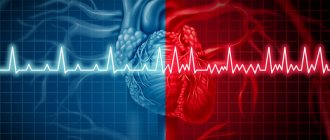If you are often worried about dizziness, increased heart rate, or pressure surges, then first of all you need to consult a neurologist (neurologist). It is an experienced neurologist at the EXPERT Clinic who will be able to carry out the differential diagnosis necessary to exclude other diseases with symptoms similar to VSD.
Neurologist Bezukh Svetlana Mikhailovna - Doctor of Medical Sciences, professor with 37 years of medical experience. The accumulated experience allows her to quickly formulate a diagnosis, prescribe only the necessary examination and effective treatment.
During the consultation, the doctor will conduct an examination and ask you in detail about your complaints - how, where exactly, in what situations your head hurts and feels dizzy, whether there are pressure surges, attacks of nausea, fainting, how long the attacks last and other questions.
The neurologist will also prescribe the necessary instrumental and laboratory examinations, which can be partially or fully completed immediately after the consultation:
- ECG
- Ultrasound of bracheocephalic vessels (head and neck)
- 24-hour ECG and blood pressure monitoring
- x-ray of the spine
- blood and urine tests.
Additionally, you may need to consult related specialists - a cardiologist, gastroenterologist, endocrinologist.
The most common manifestations of VSD
- Heart palpitations and blood pressure fluctuations,
- Weakness, feeling of incomplete inspiration, feeling of lack of air,
- Tremors, chills and a feeling of internal trembling,
- Nausea and dizziness,
- Unpleasant sensations (sometimes pain) in different parts of the body, most often in the head, neck, chest, abdomen,
- Feeling of numbness, chills or heat in different parts of the body,
- Increased anxiety
- Sleep disorders (insomnia or excessive sleepiness),
- Fatigue and distractibility, irritability or tearfulness,
- Rise or fall in temperature.
Doctors make such a conclusion in cases where during the examination they do not find any gross pathology (infection, mechanical damage, inflammation, allergy, poisoning, etc.) that could cause such symptoms.
Please note that there is currently no such diagnosis as VSD. VSD is a conclusion, a statement of the absence of gross pathology.
The prevalence of manifestations of vegetative-vascular dystonia is high: according to doctors, up to 80-90% of the adult population experienced symptoms of VSD; most often such cases did not reach doctors (as they went away on their own in a short time).
Terms such as neurocirculatory dystonia (NCD), vegetative neurosis (vegetative neurosis), autonomic dysfunction are synonyms for vegetative-vascular dystonia (VSD).
Since the autonomic nervous system is part of the nervous system responsible for the functioning of all internal organs, manifestations of VSD can affect different systems of the body, which explains such a variety of symptoms.
What is hidden behind vegetative-vascular dystonia?
Iron deficiency
Diarrhea
Vomit
Thyrotoxicosis
23501 November 26
IMPORTANT!
The information in this section cannot be used for self-diagnosis and self-treatment.
In case of pain or other exacerbation of the disease, diagnostic tests should be prescribed only by the attending physician. To make a diagnosis and properly prescribe treatment, you should contact your doctor. Vegetative-vascular dystonia: causes of occurrence, what diseases it occurs with, diagnosis and treatment methods.
Definition
The term “vegetative-vascular dystonia” (VSD) is used by doctors to describe a number of symptoms indicating an imbalance of the autonomic nervous system, which can be observed in various diseases.
The autonomic nervous system is that part of the nervous system that regulates the functioning of internal organs, endocrine and exocrine glands, blood and lymphatic vessels. It maintains blood pressure, heart contractility, kidney function, is responsible for body temperature, regulates metabolic processes, etc.
The autonomic nervous system consists of the sympathetic and parasympathetic divisions, whose functions are mostly opposite. Thus, the influence of the sympathetic department of the autonomic nervous system leads to increased heart rate during physical exercise or emotional stress. Activation of the parasympathetic department occurs when a person is resting - blood pressure decreases and the pulse becomes slower.
In addition to the term “vegetative-vascular dystonia”, others are used that describe the same conditions - “neurocirculatory asthenia” or “neurocirculatory dystonia” (NCD).
In fact, VSD is not a disease, but a syndrome in which there is no organic pathology of a specific organ or system, and the disorders are functional in nature.
In our country, VSD remains one of the most popular diagnoses, while in 80% of cases there are serious pathologies behind it, the identification of which should be the attention of specialists. Note that abroad the diagnosis of “vegetative-vascular dystonia” is practically not heard.
The International Classification of Diseases, 10th revision (ICD-10) does not include such diagnoses as “VSD” and “NCD” and they are not assigned a separate code, and the ICD 11th revision proposes the term “Disorders of the autonomic nervous system” to designate functional disorders of the nervous system unspecified."
Symptoms of vegetative-vascular dystonia
Patients diagnosed with VSD, NCD, or somatoform dysfunction of the autonomic nervous system usually present with a wide range of complaints. They consult a doctor with symptoms such as a feeling of weakness, fatigue, rapid heartbeat or interruptions in heart function, increased or decreased blood pressure, periods of shortness of breath, increased anxiety, irritability, fearfulness, and may even experience fainting, pain or discomfort in the heart area , abdominal discomfort, dyspeptic disorders.
These complaints may hide a number of serious diseases (anemia, thyroid disease, arterial hypertension, coronary heart disease, panic attacks, depressive or anxiety disorder, etc.), which are easy to miss, explaining the patient’s symptoms by the fact that he has a disorder of the autonomic system. nervous system.
What diseases cause vegetative-vascular dystonia?
Iron-deficiency anemia
Iron deficiency anemia (IDA) is a disease characterized by a decrease in iron content in the blood serum, bone marrow and tissues and leading to disruption of the synthesis of hemoglobin and red blood cells, and the development of trophic disorders.
Latent iron deficiency is characterized by depletion of iron reserves in the body with normal blood hemoglobin levels. Symptoms of latent deficiency or anemia are weakness, increased fatigue, decreased performance, pale skin, headache, rapid heartbeat, low blood pressure, dry skin, brittle hair and nails, and abdominal discomfort.
Iron deficiency in anemia can be caused by a lack of iron intake, impaired absorption, or increased loss.
The main causes of IDA in women: heavy menstrual bleeding, pregnancy, childbirth (especially repeated ones) and lactation. For postmenopausal women and men, the main cause is bleeding in the gastrointestinal tract. Iron deficiency can develop during periods of intensive growth in children, when following a plant-based diet, after resection of the stomach or intestines, and also as a result of impaired iron absorption in people with inflammatory diseases of the gastrointestinal tract.
Thyroid diseases
Impaired production of thyroid hormones (thyroid hormones) can lead to their excess (hyperthyroidism) or deficiency (hypothyroidism) in the blood. With hypothyroidism, the patient feels apathy and drowsiness, fatigue, memory loss, has difficulty concentrating, depression, chilliness, does not tolerate cold well, has intense hair loss, brittle nails, swelling, muscle pain, weight gain with decreased appetite , constipation. With excessive production of hormones, patients complain of rapid heartbeat, tremors of the limbs, sweating, a feeling of heat and poor heat tolerance, tearfulness, fussiness and irritability, weight loss with increased appetite, insomnia.
Thyroid diseases can have a blurred clinical picture and occur under the masks of other diseases.
In some patients, neurological symptoms predominate, in others, blood pressure increases, in others, the leading symptoms are gastrointestinal disorders - nausea, flatulence, constipation.
A number of other somatic diseases, for example, arterial hypertension
or
coronary heart disease
, may also underlie complaints that the doctor regards as dysfunction of the autonomic nervous system (especially if the patient is young). When the examination does not reveal any organic abnormalities, and laboratory tests are within or borderline the norm, this does not mean that the patient is “inventing” his poor state of health.
Functional disorders of the nervous system can accompany such mental disorders as panic attacks, anxiety or depressive disorders, etc.
Panic disorder
Panic disorder is a common disease that tends to be protracted. It is 2-3 times more common in women and usually begins at a young age. The main manifestation of panic disorder is repeated attacks of anxiety, which are called panic attacks. A panic attack is an inexplicable, painful attack of poor health, which is accompanied by various vegetative symptoms, fear and anxiety. Previously, such patients were often diagnosed with “VSD with a crisis course” or “sympathoadrenal crisis.”
The presence of at least four of the following symptoms in patients should lead the doctor to think about a possible panic disorder (and in some cases, two are enough):
- pulsation, palpitations, rapid pulse;
- sweating;
- chills, tremors, feeling of internal trembling;
- feeling of lack of air, shortness of breath;
- choking or difficulty breathing;
- pain or discomfort in the left side of the chest;
- nausea or abdominal discomfort;
- feeling dizzy, unsteady, lightheaded, or lightheaded;
- a feeling of depersonalization and lack of understanding of the reality of what is happening;
- fear of going crazy or committing an uncontrollable act;
- fear of death;
- numbness or tingling sensation (paresthesia) in the limbs;
- sensation of waves of heat or cold passing through the body.
Other signs may include abdominal pain, upset bowel movements, frequent urination, a feeling of a lump in the throat, gait disturbance, visual or hearing impairment, cramps in the arms or legs, and motor dysfunction.
Anxiety during a panic attack can be both pronounced and barely noticeable - in this case, vegetative symptoms come to the fore. The duration of the attack is 15-30 minutes.
Panic disorder is characterized by the recurrence of panic attacks, it is not caused by the action of any substances or somatic disease (heart rhythm disturbance, thyrotoxicosis, hypertensive crisis), it is characterized by a person’s constant concern about the recurrence of attacks. Usually the first attack makes a painful impression on the patient, leading to constant anxiety and anticipation of repetitions. The more catastrophic a person assesses the first episode (for example, he believes that he is developing a heart attack or stroke), the more severe the panic disorder is and the faster concomitant diseases can join (depression, agoraphobia, alcoholism, etc.).
Generalized anxiety disorder
Generalized anxiety disorder (GAD) is widespread and persistent anxiety and tension that is not caused or limited by any environmental circumstances - so-called “free-floating anxiety.” Among the adult population, about 5% suffer from this disorder, most often women are patients. The disease usually appears between the ages of 20-35 years.
GAD can have a chronic course with periods of exacerbations and remissions. The anxiety state with GAD lasts at least 6 months, is not amenable to conscious control (the patient is not able to suppress anxiety through willpower or rational beliefs), and the intensity of the experience is disproportionate to the reality of life circumstances.
The main symptom of generalized anxiety disorder is diffuse anxiety that is not associated with specific situations, that is, the patient is constantly tense in anticipation of something bad, restless, and preoccupied for various reasons.
Other symptoms include irritability, increased vigilance, difficulty concentrating, and sensitivity to noise. The disease is characterized by muscle tension, which is accompanied by tremors of the limbs, inability to relax, increased muscle tone, headache, and aching muscle pain.
In generalized anxiety disorder, symptoms associated with increased activity of the autonomic nervous system are very common: dry mouth, difficulty swallowing food and water, abdominal discomfort, flatulence, diarrhea, nausea. Patients complain that it is difficult for them to breathe, they feel discomfort in the heart area, interruptions in its work, and pulsation of the neck vessels. In addition, a case of erectile dysfunction, decreased libido, delayed menstruation, and frequent urination has been described.
Depressive disorder
Depression is one of the most common mental disorders. Episodes of depression are characterized by daily low mood and last at least 2 weeks. The patient experiences decreased interest in work, family, and increased fatigue. A person in a depressive episode has difficulty concentrating, has low self-esteem, is pessimistic, and has problems with appetite and sleep.
Depression can occur in the so-called hidden form, when it is not a low mood that comes to the fore, but a feeling of physical ill health.
Patients complain of lack of strength, weakness, malaise, note the appearance of unpleasant sensations or pain in the body, rapid heartbeat, nausea, and increased sweating. In such cases, doctors prescribe a series of examinations and consultations, and if even minor deviations from the norm are detected, which are in no way related to the patient’s current condition, they begin to treat him. Incorrectly prescribed treatment does not lead to relief of the patient's condition, but can cause side effects and increase anxiety. It is these patients who are often diagnosed with “vegetative-vascular dystonia”, “spinal osteochondrosis”, “cardioneurosis”, etc. But if these patients come to see a psychiatrist, then usually the doctor immediately understands that he is a person with a depressive disorder and prescribes psychopharmacological treatment.
Diagnosis of vegetative-vascular dystonia
If you suspect a disorder of iron metabolism in the body, the following examinations must be carried out:
- general blood test with determination of hematocrit, level of red blood cells in the blood, study of the level of reticulocytes in the blood with determination of the average content and average concentration of hemoglobin in red blood cells, determination of the size of red blood cells;
What causes VSD
The main mechanism that triggers vegetative-vascular dystonia is overexcitation of the subcortical structures of the brain, in which the centers of the autonomic nervous system are located. There are many reasons: from the consequences of injuries and poisoning, to overwork and stress.
Special mention should be made of mental disorders that occur with symptoms of anxiety and depression, in which autonomic disorders are observed almost constantly.
In the modern classification of diseases (ICD 10), vhetovascular dystonia is called by another term: somatoform disorders, and is included in the section of borderline mental disorders. This confirms that VSD is triggered by our brain and at the same time certain changes in the psyche are always observed.
VSD does not pose any danger to life. But due to poor health, the sick have reduced ability to work and the entire body is weakened.
Measures to prevent attacks of VSD
Unfortunately, a universal panacea to overcome an attack of VSD has not yet been found. To cope with this problem, a person should completely reconsider his usual lifestyle.
First of all, it is necessary to eliminate nervous overload, establish a work and rest schedule and change your diet, giving preference to foods rich in potassium and magnesium. You need to sleep in a well-ventilated area and at least 8 hours a day. It is worth reducing the amount of time you spend in front of a TV screen or computer monitor. If this is not possible due to the nature of your professional activity, you must take breaks, setting aside time for rest and physical activity during the day.
Daily walks in the fresh air, cycling, jogging, and aerobics are very useful. And, of course, it is necessary to put an end to bad habits that can worsen the course of the disease - smoking, excessive alcohol consumption, etc.
Treatment of VSD
Before treatment, the doctor clarifies the causes of disturbances in the functioning of the autonomic nervous system.
Usually, a conclusion is given during the first examination by a doctor, but sometimes additional studies of the functioning of the nervous system and internal organs are required: blood and urine tests, electroencephalography (EEG) and MRI (magnetic resonance imaging) of the brain, studies of mental functions (pathopsychological and neuropsychological examination ) and etc.
Treatment of vegetative-vascular dystonia may include the following techniques (and their combinations):
- Psychotherapy, biofeedback therapy.
- Drug treatment.
- Physiotherapy.
- Massage, manual therapy and physical therapy. culture (physical therapy).
- Reflexology.
- Spa treatment.
Advice to relatives of patients and patients themselves with symptoms of VSD:
- Despite the fact that VSD is a reversible and non-life-threatening condition, when symptoms of vegetative-vascular dystonia appear, the first thing you should do is consult a doctor. A therapist, neurologist, psychotherapist, psychiatrist, cardiologist or anyone else. In order to exclude serious diseases (hypertension, heart attack, stroke, diabetes, epilepsy, depression, etc.) that occur with similar symptoms. Only after the doctor states that there is VSD can you calm down.
- If you know that this is VSD, then you need to take measures to reduce anxiety and overexcitation. At home, this can include water treatments (shower, warm bath), physical activity (walking, jogging, regular sports with a preference for swimming and athletics), relaxation exercises (autogenic training, yoga, breathing exercises), suggestion and persuasion. that there is no danger behind these symptoms also has a therapeutic effect. Switching attention to another object helps well, since VSD is characterized by increased attention to one’s body and one’s feelings. For example, give some task, concern you with some problem.
- In no case should you devalue complaints and convince them that “you came up with all this on your own”, “you screwed yourself up”, “see! The doctor didn’t reveal anything about you, and you’re complaining!” and so on.". This approach will contribute to the transition of anxiety into a chronic course and the formation of protracted neuroses.
- The most useful specialist for VSD is a psychotherapist. With the help of psychotherapy, it is possible to reduce or remove pathologically increased anxiety, which is the core of vegetative-vascular dystonia. Therefore, if you manage to organize a consultation with a psychotherapist, especially a good psychotherapist, consider that you have solved the problem!
How to prevent or stop an attack of VSD
If you want to prevent an attack of VSD or get out of it with the least loss to the body, you need to analyze and, if possible, eliminate the conditions that provoke the development of this condition.
If the cause is fear, severe emotional shock or another external irritant, you need to try to take control of your emotions, think about something distracted, close your eyes, massage your eyelids. To stop an attack of VSD, it is also worth providing an influx of fresh air (open a window, unbutton a collar, or get rid of items of clothing that impede breathing). To improve cerebral circulation, you should lie down or at least take a comfortable sitting position.
To cope with an attack of migraine-like VSD, you need to go to a quiet place where there is no bright light. If your blood pressure increases or decreases, it is recommended to take the appropriate medication. A hot foot bath or a warm blanket will help overcome chills. In addition, at the first sign of an approaching panic attack, it is recommended to eat something sweet and drink a glass of water in slow sips.
Since it is not always possible to relieve an attack of VSD on your own, experts recommend taking a sedative.
Without professional medical help, panic attacks can become more frequent, gaining strength each time. Therefore, people prone to repeated exacerbations should definitely visit a neurologist. An experienced doctor will be able to advise how to get rid of an attack of VSD, select the optimal treatment regimen and tell you what to do during the next vegetative-vascular crisis.
How to identify the real cause of illness
If the doctor you consulted diagnosed you with VSD and did not prescribe any additional examinations, consult another specialist. In most cases, a neurologist and a psychiatrist can understand the real causes of VSD symptoms.
There is no need to be afraid of a psychiatrist. You are not included in any register, are not registered and are not classified as a group of people with severe mental disorders. People with depression, increased anxiety, panic attacks, and sleep disorders (for example, insomnia) turn to a psychiatrist. And in all these cases, the doctor can really provide qualified assistance.
A psychiatrist, neurologist or cardiologist will prescribe the following diagnostic procedures for you
:
- Clinical analysis of blood and urine
- Blood chemistry
- ECG or EchoCG
- Chest X-ray
- Ultrasound of the abdominal cavity (for complaints of pain and discomfort in the gastrointestinal tract)
- MRI of the brain and EEG (for complaints of headaches and dizziness)
After evaluating the research results, the doctor may refer you to a gastroenterologist or endocrinologist. This means that the real cause of your malaise lies in a gastrointestinal disease or hormonal imbalance.
Vegetative-vascular dystonia: persistent symptoms
- Cardialgia. Pain in the left side of the chest that is not due to heart damage. These symptoms are not specific to VSD; they can occur in many other diseases.
- Heartbeat problems . Common symptoms of VSD are rapid or slow heartbeat, irregular heart rhythm (arrhythmia).
- Vascular dystonia . Constriction of blood vessels causes blood flow to slow down. Because of this, internal organs suffer, which do not receive enough oxygen and nutrients.
- Respiratory disorders . Shortness of breath, difficulty breathing, feeling of lack of air.
- Systemic neurotic disorders . The patient suffers from insomnia and nervousness.
Exacerbation of VSD and features of the course
Despite the fact that VSD is not an independent disease, but only combines a set of symptoms characteristic of emotional and psychological disorders, it can lead to the development of diseases of organs and systems. Against the background of imbalance, the following may develop:
- bronchial asthma;
- hypertension;
- stomach ulcer;
- heart diseases.
The disorder occurs in different ways: in the form of constant deviations in the functioning of organs and systems or pronounced short-term attacks. Often the course of dystonia is unnoticed until a stressful situation occurs, when its symptoms become apparent.
Exacerbations can be seasonal or occur in response to physiological changes. For example, in women, exacerbation can occur during pregnancy or during menstruation.
In winter, the syndrome becomes more active due to decreased immunity and frequent infectious diseases. In spring - hypovitaminosis and the body's natural need for sunlight, a deficiency of which most of us experience throughout the winter. In summer, the body is negatively affected by heat; in autumn, there is a general dreary picture outside the window, full of grayness and depressive notes.
“External reasons, of course, can provoke an exacerbation of VSD,” explains neurologist Olesya Bryukhanova. “But most often the cause is stress, mental and emotional stress.”
Vegetative-vascular dystonia in men
Alexey, 30 years old, former patient of the Clinical Center for Autonomic Neurology: “I went to the clinic in August 2021. I was worried about the symptoms of panic attacks: anxiety attacks, rapid heartbeat, fear of leaving the house, sometimes choking, the condition often felt like a hangover. Some time after severe stress, a feeling of suffocation at night and insomnia were added. I could go to bed at 10 pm and fall asleep at 6 am.” (full interview here - Alexey, 30 years old, panic attacks)
Men and women have different psychology and different physiology. This is reflected in the causes of the disorder, its symptoms and the speed of contacting a specialist.
The peculiarities of the course of vegetative-vascular dystonia in men are that, due to their psychology, they often withdraw into themselves and may not consult a doctor for a long time, since they are accustomed to being the support of the family and coping with any difficulties on their own. Men can spend years trying to overcome their own illness on their own, not considering it a disease. And this has a very bad effect on your future well-being. Therefore, with vegetative vascular dystonia in men, it is important that loved ones help ensure that the patient contacts a qualified specialist as soon as possible.
Vegetative vascular dystonia in men occurs because they, as a rule, keep all negative emotions and a feeling of dissatisfaction with their own lives. It is more difficult for them to relieve internal tension (“men don’t cry”). They are more likely to ignore their poor health. And when the first signs of vegetative-vascular dystonia appear, they even try to “drown out” the symptoms with alcohol. And here loved ones must again be very vigilant! It is also worth noting that vegetative vascular dystonia in both women and men can cause weakened sexual function and decreased sexual activity, which is quite natural from both a physiological and psychological point of view.
Types of VSD
The nature of the manifestation of signs of VSD directly depends on the condition of the blood vessels. Based on this, the following types of vegetative-vascular dystonia are distinguished:
- hypertensive;
- hypotonic;
- mixed;
- cardiac;
- vagotonic.
But symptoms are extremely rarely present all the time. Most often they are in the nature of attacks. Not all of the signs characteristic of a particular type of vegetative-vascular dystonia always appear. Moreover, this is rare. Typically, patients complain of 2-3 disorders, the presence of which, in combination with the results of the examinations, makes it possible to determine the specific type of vegetative-vascular dystonia.
Based on how VSD occurs, there are 3 degrees of severity of the disorder:
- mild – patients fully retain their ability to work, symptoms of VSD do not cause them significant discomfort, and there are no vegetative crises;
- moderately severe – periods periodically occur during which a person loses ability to work due to exacerbation of vegetative-vascular dystonia and the development of a vegetative crisis;
- severe - a long, persistent course of VSD with frequent periods of exacerbation and crises, which leads to a significant decrease in performance.
Hypertensive type
Patients experience pronounced vascular tone, as well as a persistent increase in blood pressure. Their main complaints focus on the occurrence of:
- rapid heartbeat;
- hot flashes;
- headaches;
- constant fatigue;
- nausea, vomiting, attacks of which are not associated with eating;
- decrease in appetite up to its complete loss;
- sweating (during an attack there is severe sweating of the palms);
- causeless but strong fear;
- flickering “flies” before the eyes.
Hypotonic type
Characterized by low blood vessel tone and low blood pressure. Therefore, patients are often annoyed by:
- episodes of darkening of the eyes;
- a sharp decrease in blood pressure;
- severe weakness;
- loss of consciousness;
- pale skin;
- nausea, heartburn;
- changes in bowel habits (diarrhea or constipation);
- inability to take a full breath.
It can be noted that in patients with VSD of the hypotonic type, the palms and feet are constantly cold.
Mixed type
With this variant of VSD, variability in vascular tone is observed, so blood pressure can fluctuate within a fairly wide range. It can rise sharply to high levels and then suddenly drop to extreme levels.
In such cases, there is a change in the symptoms of VSD, which occurs according to the hypertensive type, with manifestations of VSD of the hypotonic type. This significantly affects the lives of patients, as attacks of weakness, profuse sweating and fainting states are replaced by hot flashes, tachycardia and headaches.
During an attack, there is often a fear of imminent death and the inability to take a full breath, which further aggravates the situation. Pain in the heart area may be present.
Cardiac type
This type of VSD is diagnosed when aching, throbbing pain occurs in the heart area, which does not have a significant effect on a person’s general well-being. They may be accompanied by arrhythmia and profuse sweating, but the examinations carried out do not reveal heart pathologies.
Vagotonic type
For this type of vegetative-vascular dystonia, the occurrence of breathing disorders is typical. Patients often complain of the inability to take a full breath and a feeling of tightness in the chest. In this case, there may be a tendency to lower blood pressure and slow heartbeat. But with the vagotonic type of VSD, there is an increase in salivation and changes in the functioning of the organs of the digestive system.









